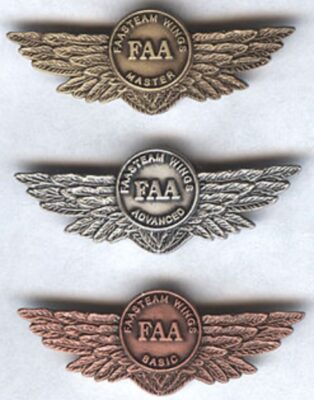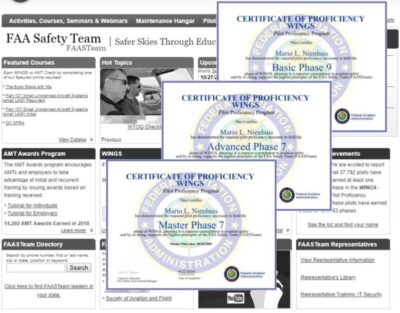 by: Brian Moor
by: Brian Moor
Proficiency training is so beneficial to aviation safety that it is a regular requirement of professional pilots. Proficiency training is also beneficial to general aviation pilots. Studies have clearly demonstrated that pilots who participate in regular proficiency training are much less likely to experience accidents. The FAA WINGS Pilot Proficiency Program is one way for general aviation pilots to ensure they are competent, confident, and safe in their flight operations. Let’s examine the top 5 reasons to be a WINGS Pilot.
Reason 5: Documented WINGS proficiency training earns awards! To be clear – we don’t choose proficiency training because it’s easy or because we’re looking for bling but it is nice to be recognized for our achievements. As a WINGS pilot you are recognized as a member in good standing of the General Aviation Safety Community. All of your WINGS training is permanently recorded in your online WINGS logbook and when you earn a WINGS phase you can receive a lapel pin. Aircraft insurance carriers recognize the value of regular Proficiency Training and they may offer premium discounts to WINGS pilots. And there’s yet another reward opportunity for every pilot who earns a WINGS phase. Every time you complete a WINGS Phase you’re eligible to win cash in the WINGS Sweepstakes. The sweepstakes is generously funded by Paul Burger, a longtime advocate for general aviation safety and a retired aviator who believes participation in this program saves lives. VISIT http://www.mywingsinitiative.org to learn more and enter the sweepstakes. By the way, Instructors can enter the sweepstakes too!
Reason 4: Proficiency training works! Can you imagine how well professional athletes would perform if they didn’t practice between games or stay in shape during the off season? Or how about a professional flight crew who never train for emergencies? Pros know that proficiency is not a destination but rather a journey (that never ends). Regular training keeps them at peak performance every time they take to the air. Pilots who follow the Path to Proficiency are well aware of their capabilities and their limitations. They dedicate time and resources to training and practice. And they understand that continuing education through Proficiency Training is essential to keeping them on top of their game. Proficiency training works for General Aviation pilots too. WINGS is a proficiency training system specifically designed for GA pilots and, regular participation will keep you on top of your flying game. Pilots who participate in the FAA WINGS Pilot Proficiency program fly with confidence. They and their passengers are comfortable in the air. Most importantly – proficiency training keeps us safe. And pilots who earn WINGS phases also qualify for a flight review! In fact, completion of any phase of WINGS satisfies the 14 CFR 61.56 requirements for Flight Reviews.
Reason 3: WINGS coaching gets results! Every profession relies on coaching to keep practitioners sharp. All Flight Instructors are trained in performance evaluation and critique and most make great coaches. WINGS Instructors are expert in your aircraft and the training environment. They are keen observers and teachers who will push you to excellence in flying. Together you and your WINGS CFI can develop your Personal Minimums – a set of conditions, procedures, rules, criteria, and guidelines to help you decide when it’s safe to fly. As the name implies, your Personal Minimums are unique to you and keyed to your demonstrated ability. In consultation with your coach, you’ll develop and document your personal minimums based on your individual performance. Pilot performance changes over time and WINGS pilots continue to improve. WINGS training gives you regular opportunities to review and update your performance profile and personal minimums, but you need a reference point to start – a baseline; think of it as your personal, documented, demonstration of performance. It is suggested that you document your performance at least once a year with a WINGS CFI. Try to pick a day when you can experience actual cross-wind conditions in the airplane you usually fly and loaded to your typical mission weight. Select an airfield that’s typical for the missions you fly. If you’re planning trips to a short, obstructed runway; try to find something similar to train on. Gather information about the destination airfield from pilots who’ve flown there and share that information with your instructor. That will help your CFI to construct realistic scenarios for you to fly. Structured WINGS Activities are already developed and available for nearly any scenario you can think of.
Reason 2: WINGS proficiency training expands your horizons! Pilots tend to think of proficiency training in terms of their usual aviation operations but if you are willing to expand your horizons, there are a host of options that go well beyond the hundred dollar hamburger to make proficiency flying more interesting. Twin engine, turbine, or instrument training can boost capability and confidence in cross country operations. Seaplane and tailwheel training are particularly satisfying for folks who learned in nose wheel airplanes. And even if you don’t take on the challenges of another rating or airframe, there’s another great way to expand your horizons. Training in new operational environments builds confidence too. If you learned to fly at a small country airport you’re probably very comfortable in a non-towered environment. How about a trip to a major metropolitan airport with your flight coach? The traffic and rapid pace of ATC communications can be daunting at first but mastering the environment is very satisfying. Likewise, big city pilots who are comfortable with busy towered operations can be overwhelmed when operating to non-towered or back country airstrips. Back country transition training can acquaint you with the nuances of rural environments and ensure your wilderness flying can be done safely. A solid review of stalls, slow flight and spins is a great way to prevent loss of control accidents and it’s a natural stepping stone to aerobatic training. Once again WINGS CFIs can coach you to realize your maximum performance potential!
Reason 1: WINGS training yields Proficiency and Peace of Mind! There’s nothing like the feeling you get when you know you’re playing your A game and in order to do that you need good coaching. WINGS pilots are competent. They fly regularly with a WINGS CFI who challenges them to review what they know, explore new horizons, and to always do their best. Vince Lombardi, the famous football coach said, “Practice does not make perfect. Only perfect practice makes perfect”. For pilots that means flying with precision, on course, on altitude, on speed all the time. WINGS pilots are confident; they are aware of their capabilities and their limitations. They are coached to exercise sound pre and in-flight risk management so they are rarely surprised by unanticipated conditions. Of course they must dedicate time and money to their proficiency programs but it’s worth it for the peace of mind that comes with confidence. And, most importantly; WINGS pilots and their passengers enjoy the benefits of safe flight operations every time they take to the air.
Proficiency Training works best if it’s not done all at once, but rather spaced out at regular intervals. The WINGS “Topic of the Quarter” program consists of eight activities pursued over the course of one year. Because a full year’s proficiency is mapped out for you, it’s an excellent way to get started with WINGS. Each quarter, WINGS Pilots take an on-line safety course. All courses are self-paced. Most take no more than an hour or two and they can be completed at home. The online courses build solid decision making skills that you’ll employ on the ground and in the air.
WINGS is a robust proficiency training program that works for all pilot certification levels and all general aviation aircraft. As such, it can be a little intimidating at first. That’s why volunteer WINGSPros in your area are available to help you with anything related to WINGS. To find your local WINGSPros just navigate to http://www.FAASafety.gov; or talk with your favorite CFI to get started with WINGS.